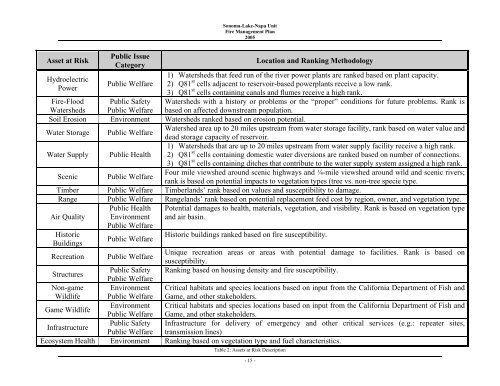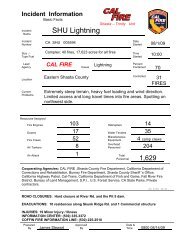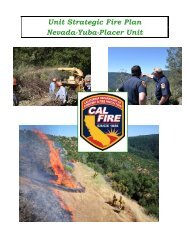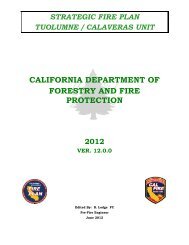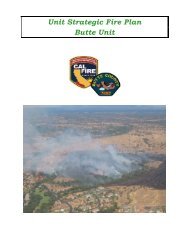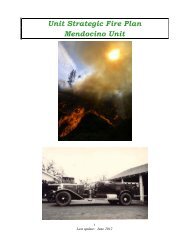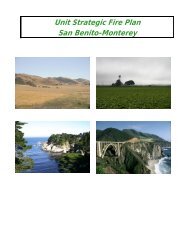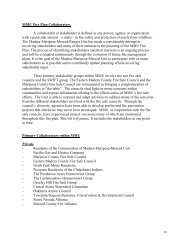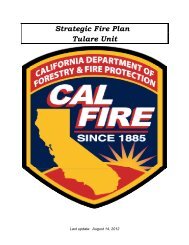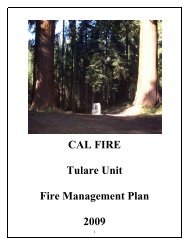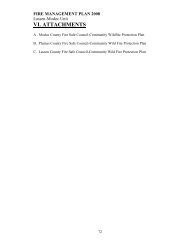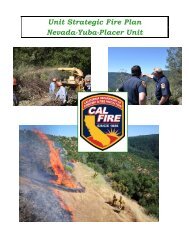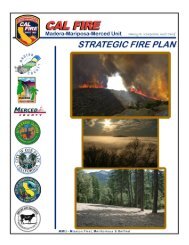Sonoma-Lake-Napa Fire Plan - Board of Forestry and Fire ...
Sonoma-Lake-Napa Fire Plan - Board of Forestry and Fire ...
Sonoma-Lake-Napa Fire Plan - Board of Forestry and Fire ...
Create successful ePaper yourself
Turn your PDF publications into a flip-book with our unique Google optimized e-Paper software.
Asset at Risk<br />
Hydroelectric<br />
Power<br />
Public Issue<br />
Category<br />
<strong>Sonoma</strong>-<strong>Lake</strong>-<strong>Napa</strong> Unit<br />
<strong>Fire</strong> Management <strong>Plan</strong><br />
2005<br />
- 15 -<br />
Location <strong>and</strong> Ranking Methodology<br />
1) Watersheds that feed run <strong>of</strong> the river power plants are ranked based on plant capacity.<br />
2) Q81 st cells adjacent to reservoir-based powerplants receive a low rank.<br />
Public Welfare<br />
3) Q81 st <strong>Fire</strong>-Flood Public Safety<br />
cells containing canals <strong>and</strong> flumes receive a high rank.<br />
Watersheds with a history or problems or the “proper” conditions for future problems. Rank is<br />
Watersheds Public Welfare based on affected downstream population.<br />
Soil Erosion Environment Watersheds ranked based on erosion potential.<br />
Water Storage Public Welfare<br />
Watershed area up to 20 miles upstream from water storage facility, rank based on water value <strong>and</strong><br />
dead storage capacity <strong>of</strong> reservoir.<br />
1) Watersheds that are up to 20 miles upstream from water supply facility receive a high rank.<br />
Water Supply Public Health 2) Q81 st cells containing domestic water diversions are ranked based on number <strong>of</strong> connections.<br />
3) Q81 st cells containing ditches that contribute to the water supply system assigned a high rank.<br />
Scenic Public Welfare<br />
Four mile viewshed around scenic highways <strong>and</strong> ¼-mile viewshed around wild <strong>and</strong> scenic rivers;<br />
rank is based on potential impacts to vegetation types (tree vs. non-tree specie type.<br />
Timber Public Welfare Timberl<strong>and</strong>s’ rank based on values <strong>and</strong> susceptibility to damage.<br />
Range Public Welfare Rangel<strong>and</strong>s’ rank based on potential replacement feed cost by region, owner, <strong>and</strong> vegetation type.<br />
Public Health Potential damages to health, materials, vegetation, <strong>and</strong> visibility. Rank is based on vegetation type<br />
Air Quality Environment<br />
Public Welfare<br />
<strong>and</strong> air basin.<br />
Historic<br />
Buildings<br />
Public Welfare<br />
Historic buildings ranked based on fire susceptibility.<br />
Recreation Public Welfare<br />
Unique recreation areas or areas with potential damage to facilities. Rank is based on<br />
susceptibility.<br />
Structures<br />
Public Safety<br />
Public Welfare<br />
Ranking based on housing density <strong>and</strong> fire susceptibility.<br />
Non-game Environment Critical habitats <strong>and</strong> species locations based on input from the California Department <strong>of</strong> Fish <strong>and</strong><br />
Wildlife Public Welfare Game, <strong>and</strong> other stakeholders.<br />
Game Wildlife<br />
Environment<br />
Public Welfare<br />
Critical habitats <strong>and</strong> species locations based on input from the California Department <strong>of</strong> Fish <strong>and</strong><br />
Game, <strong>and</strong> other stakeholders.<br />
Infrastructure<br />
Public Safety<br />
Public Welfare<br />
Infrastructure for delivery <strong>of</strong> emergency <strong>and</strong> other critical services (e.g.: repeater sites,<br />
transmission lines)<br />
Ecosystem Health Environment Ranking based on vegetation type <strong>and</strong> fuel characteristics.<br />
Table 2: Assets at Risk Description


